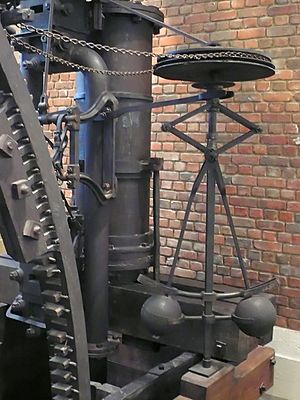Control theory facts for kids
Control theory is a cool mix of engineering and mathematics. It helps us understand how different systems work. The goal you want a system to reach is called its reference. Think of it like this: you give a system some instructions (inputs), and those instructions change what the system does or how it acts.
Control theory asks important questions like:
- Is the system steady and not going crazy?
- How much does the system change if you tweak its settings?
- Are all its parts working within safe limits?
- Can the system reach a specific goal?
- If it can reach the goal, what instructions do we need to give it?
One of the first modern thinkers to talk about control theory was James Clerk Maxwell. In 1868, he wrote about how centrifugal governors worked. These devices were used to control the speed of steam engines and even windmills.
What is a Mathematical Model?
A system is like a simplified version of something real. It helps us describe how things work by showing what goes in (inputs) and what comes out (outputs). For example, a car is a system. When you press the gas pedal (input), the car moves at a certain speed (output).
But a car's speed isn't just about how hard you press the gas. Things like how much weight is in the car, if the road is uphill, how good the tires are, or how fast the car is already going can all change its speed. Control theory tries to figure out what inputs will give you the exact output you want. To do this, it uses advanced math like calculus and linear algebra. It also uses a lot of computer models and software.
How Does a Control System Work?
In a control system, a special part called a controller changes the inputs to a system. The main idea is to make one or more outputs of the system follow a specific path over time. By changing the input, the controller aims to get the desired result from the system's output.
Imagine a system without a controller. It would just have an input and an output. You couldn't really guide it to do what you want. But if you add a controller, it can take the output, check it, and then adjust the input. This way, the output can be made to meet your goals.
For example, if a kettle didn't have a controller, it would just keep boiling water forever once you turned it on. But with a controller, the controller "sees" that the water is boiling (the desired output). It then tells the kettle to turn off the power.
- A system without a controller is called an open-loop system. These are usually not very stable because you can't adjust them based on what they're doing.
- When you add a controller that uses the output to adjust the input, you create a closed-loop system. These systems are much better at reaching and holding a desired state.
Images for kids
See also
 In Spanish: Teoría del control para niños
In Spanish: Teoría del control para niños



